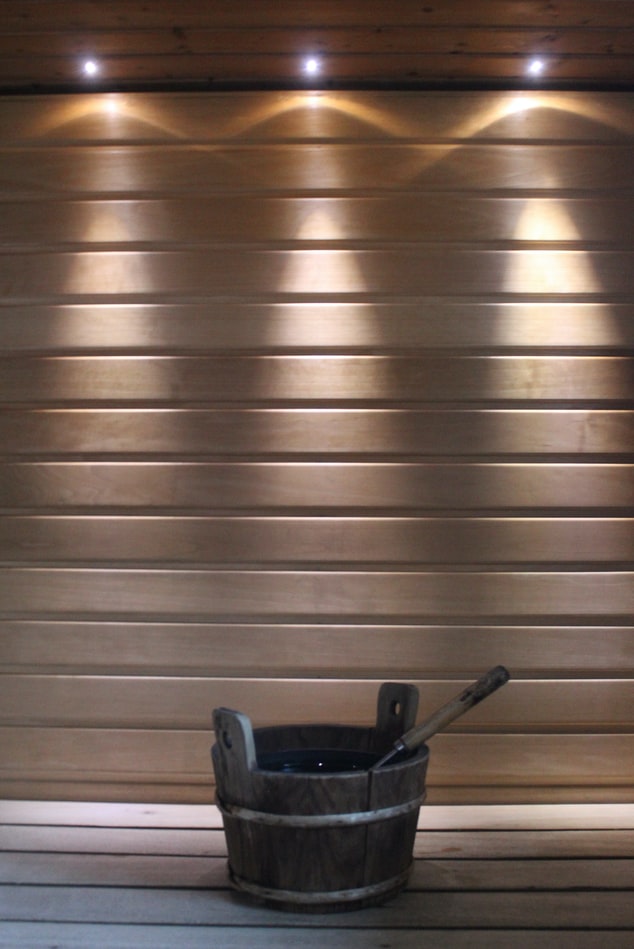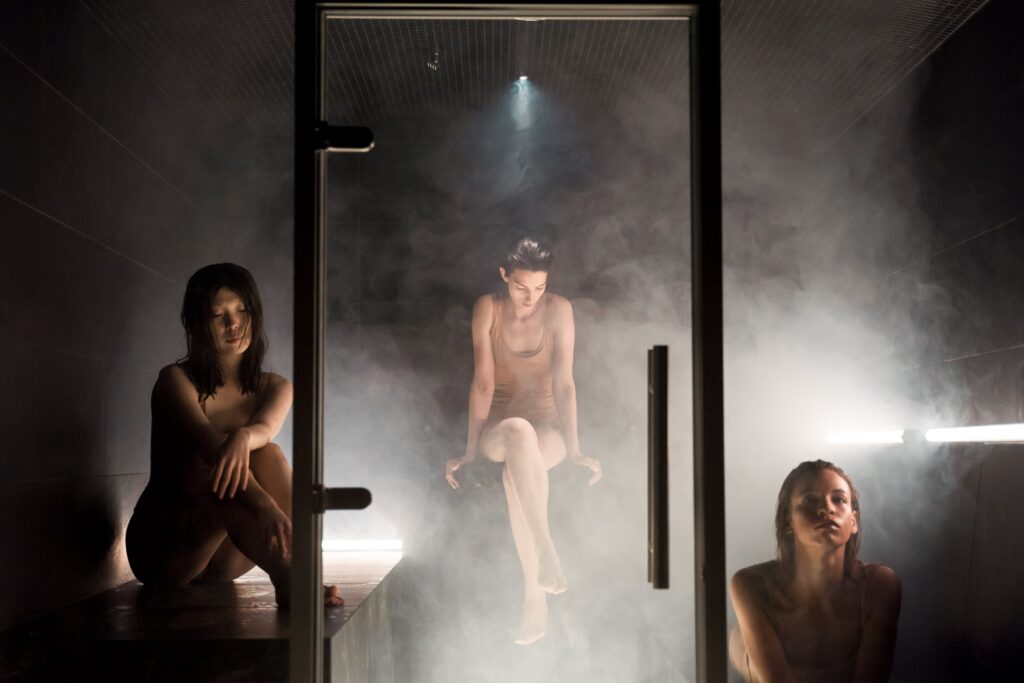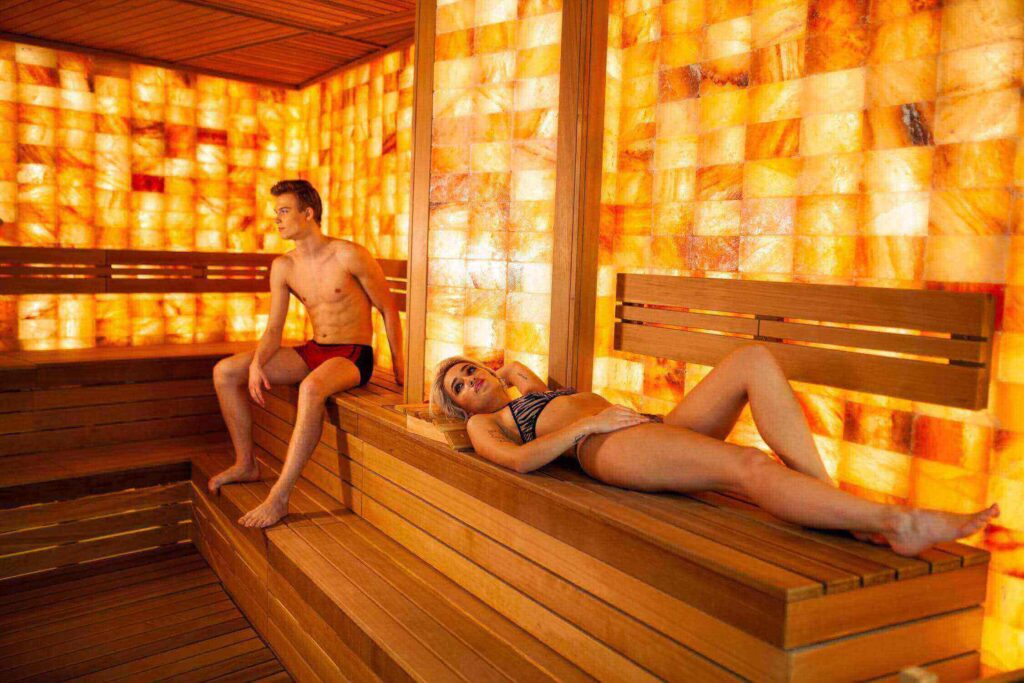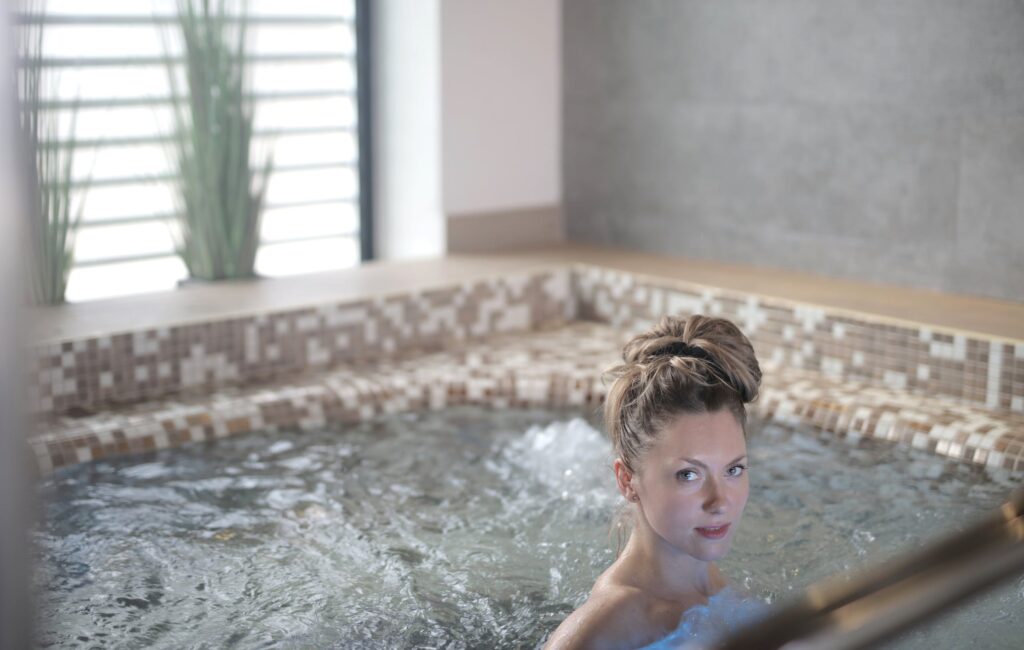Chimneys weren't installed in northern European buildings until the onset of the industrial revolution in that region. This made it possible for saunas to maintain a consistent and rapid temperature even after people had entered them (as long as they added wood).
Although these continuously wood-fired saunas are now what the majority of people think of when they think of a sauna, the older forms of saunas without chimneys, which are now termed smoke saunas, still exist in various locales and are still thought of as the greatest.
Around the turn of the 20th century, smoke saunas started to give way to iron stoves that expelled the smoke up a chimney.
The culture of the Finnish sauna was carried with the Finns wherever they went and wherever they lived. This is due to the fact that it played such an important role in their lives.
The first electric sauna stoves were invented in the 1950s in the United States, and this technology swiftly spread throughout the rest of the world, including back to the country that was responsible for the invention of the sauna.
Electric stoves have made saunas more user-friendly and available to a wider audience. It is estimated that there are 2 million saunas in Finland, which has a total population of approximately 5 million people. Therefore, it is important to note that those who initially conceptualized the benefits of the sauna continue to remain convinced of its usefulness.
The Tylo sauna collection carries on this illustrious history of wellness and pleasure while bringing it bang up-to-date in terms of both its technological capabilities and its aesthetic appeal.
The rise in popularity of Finnish saunas, on the other hand, can be somewhat attributed to developments in contemporary geopolitics.
Even though they are both commemorating their 100th anniversary as independent republics at the same time, Finland and Estonia couldn't be more different in terms of the fortunes they've encountered over the course of the majority of that period. The Soviet Union conquered Estonia at this time, while Finland managed to maintain its independence.
As a consequence of this, the Finns took advantage of their increasing affluence and freedom to upgrade the traditional design of their saunas and to continue disseminating the practice across the globe amid waves of migration toward the west.
Finland is credited for inventing the first electric sauna, which was later made popular in the United States in the middle of the 20th century. Because of this, a much larger number of individuals were able to enjoy the benefits of saunas, despite the fact that they provided an apparently inferior source of heat. In addition to this, it means that saunas could now be constructed with relative ease inside spas, gyms, and hotels all around the western world and beyond.
The fact that most customs were disregarded in saunas, while swimming attire was not one of them, contributed to the widespread perception that saunas were places of public recreation.
Electric saunas made their way back to Finland, where many of its wood-fired predecessors were eventually replaced with electric models.
To sum up, we'll never know for sure who came up with the idea for the sauna. There is sufficient evidence to suggest that the Finnish invented it because it plays such a vital role in both their day-to-day lives and their culture. However, this does not prove that they were the original creators of the sauna. All that is left for us to do at this point is to offer our gratitude to whoever invented the sauna, as well as to those who have worked to improve upon it, and then to take advantage of the contemporary saunas that are available to us today.
FAQs About Sauna
Saunas appear safe for most people. However, people with uncontrolled high blood pressure and heart disease should check with their doctors before taking a sauna. Here are some general precautions: Avoid alcohol and medications that may impair sweating and produce overheating before and after your sauna.
Using a sauna to aid in your weight loss goals will only work if you are also eating and drinking less calories than you are burning. Some sources estimate that one can burn up to 600 calories in an hour-long sauna session, while others say it is as low as 50.
Collagen — the protein in our skin responsible for elasticity — gets a healthy kick when you spend time in a sauna. The hot air combined with moisture enhances collagen production to help rejuvenate your complexion. The heat increase also allows your skin to shed dead skin cells and make way for new, healthier ones.
You can protect your hair by using a sauna hat, a dampened or dry towel. You can put on a hair mask on while taking a sauna. The heat of the sauna lets the mask work more effectively. Finally, rinse your hair with cold water.
The benefits of a hot tub are similar to a sauna. They both achieve stress relief, improved sleep, muscle relaxation, and cardiovascular improvement. However, the difference is a hot tub has more offerings such as massaging jets, hydrotherapy options, relaxing sounds of water, and sore muscle relief.
What Is A Traditional Sauna?
Dry saunas, also known as traditional saunas, are a cultural phenomenon that originated in Finland. These types of saunas may be discovered in health resorts, fitness centers, and hotels all over the world today. An electrical unit is used to provide heat for the dry sauna. This device heats the stones that are placed on top of it, as well as the walls of the enclosure and the air that is trapped within it. The buildings are constructed of wood and have the appearance and texture of rustic cottages.
In most cases, the temp of these units falls somewhere in the range of 80 and 100 degrees Celsius. The stones are heated, and then water is poured over them to create a humid environment and raise the temperature in the room.
These heat therapy units are almost always seen in communal settings, but they can also be constructed into individual residences. A conventional sauna is an efficient form of heat therapy because it is able to raise the core body temperature of the body, which in turn causes an excessive amount of perspiration to be produced.
Numerous individuals may experience discomfort as a result of the extremely high temperature of these devices. The experience has the potential to test the limits of its participants, and a great number of people will be unable to derive the full advantages of heat therapy merely due to the fact that the air temperature is quite high.
What Is An Infrared Sauna?
In point of fact, a more accurate description of an infrared sauna would be a "light bath." For instance, Dr. Harvey Kellogg, who invented the infrared sauna, referred to his early versions of the device as "Incandescent Light Baths" when he built them in the late 19th century. A wooden building that resembles a small cabin serves as the enclosure for the infrared light bath, much as it does for traditional saunas.
Light in the near, middle, and far infrared ranges are all naturally occurring components of the larger spectrum of light that the sun emits into space. The infrared spectrum cannot be seen by the human eye but can be experienced as warmth.
The infrared heat emitters located inside the container cause the temperature to rise to anywhere between 100 and 150 ℉. However, due to the characteristics of the wavelengths of infrared light, there does not need to be a significant rise in temperature for the light to have a significant impact on the body.
Infrared light is able to readily pass through the dermis and reach the deeper layers of the body, which include the soft tissues. Because of this, the temperature at the center of the body rises from the inside out, and the production of sweat is not dependent on the temperature of the environment outside the body.
The infrared light excites the cellular mechanism of the body as it passes through the first membrane of the skin and into the body's soft tissue. This occurs as the light penetrates further into the body. The human body is made up of 50 trillion cells, and within each of those cells is something that may be called an "energy plant" called the mitochondria. The mitochondria are the sites where ATP (adenosine triphosphate) is produced. The mitochondria are exceptionally sensitive to any and all forms of light, but they are especially sensitive to the deeply penetrating rays of the infrared spectrum. Therefore, the creation of ATP is exponentially boosted the moment that the body is subjected to infrared light.
Comparing Similarities of Traditional Saunas vs Infrared Saunas
To begin, let us examine the ways in which the rooms are comparable as well as the benefits that they share. The purpose that one seeks to achieve by using a sauna is, of course, going to vary from person to person. However, let's assume that your overall objective is to take advantage of the many health benefits that come with using a heat bath, including the alleviation of aches and pains, relaxation, and stress reduction. These advantages can be gained from either form of the sauna, despite the fact that the circumstances in which the advantages are attained are very dissimilar.
The induction of a self-induced fever through the use of a sauna contributes significantly to the list of health benefits associated with heat bathing. Hippocrates, who is considered to be the "Father of Medicine," made the observation that "Give me fever, and I can heal every disease." Even if this is an exaggeration, it does point out the potential for elevated body temperature to aid in the healing process.
Both types of saunas will have a somewhat dry atmosphere. Unless the far-infrared rooms have been on for extended periods, they typically have humidity levels that are comparable to those seen in a typical home. Before any water is poured over the rocks, the classic sauna will have a lower humidity (ten percent or less). The typical sauna is the only type of bath in which the user has control over both the temperature and the humidity. The user decides how much water should be dumped on the rocks in order to get the desired level of humidity. You have control over the temperature with far-infrared saunas, but the humidity remains constant throughout the experience.
You will enjoy profound relaxation when you sweat it out in one of the two saunas, tight muscles will be loosened, and aching joints will probably receive some relief. The quantity of calories expended during the act of perspiration is controversial and varies from person to person because it is dependent on how much an individual sweats. The majority of the weight loss in a sauna is water weight, which can be gained back once the body has been adequately rehydrated. On the other hand, there is no question that sauna time can play a significant role in a good weight loss program.
Comparing Differences between Traditional Saunas vs Infrared Saunas
In order to examine the distinctions that exist between traditional saunas and IR saunas, I will first break these distinctions down into three categories: verifiable, theoretical, and artificial differences.
It is vital to address the disparities in this manner because there are numerous perspectives regarding saunas, most of which are based on personal experience, traditional beliefs, and market competition rather than scientific truths. Therefore, we will address the distinctions that can be verified, also known as the facts, below.
How each sauna is used
Traditional saunas in Finland are not only utilized as a location to improve one's health and well-being but also as a gathering place for people to spend time with their families and friends. This practice is still carried out in modern times, with the majority of households in Finland devoting at least twice or thrice a week to communal sauna bathing. The sauna is a location where individuals may go to simply unwind and be with one another; it is also a place where friends can get together, and it can even be used to strengthen professional ties. The traditional sauna offers a number of social benefits, which is one of the reasons why it continues to be so popular in Finnish society. Although many individuals do use the sauna on their own, these benefits are among the most notable aspects of the traditional sauna.
A conventional sauna session can also be a highly personalized experience, with many participants designing a setting that is tailored to their preferences and requirements. Heat and humidity are the most popular ways that people do this since they can be completely controlled by the amount of or how little water is placed on the heated sauna rocks and what temperature they are heated to. In other words, the most common way that people do this is with the temperature and humidity. When you have the luxury of making your own steam, you have the choice to incorporate a variety of essential oils and fragrances into it, which opens the door to the possibility of engaging in aromatherapy.
In general, a significant portion of the satisfaction that comes from owning a classic sauna lies in the process of determining which environment is the most pleasurable and learning how to make adjustments to this environment based on what you hope to achieve during a given session in the sauna. Many people use traditional saunas with the intention of producing the well-known Finnish loyly, also known as "sauna steam," which is regarded as an essential component of authentic sauna bathing. This steam, in conjunction with adequate ventilation, is what really contributes to the true and pleasurable experience that one has in a sauna.
In contrast side, infrared saunas are nearly exclusively marketed as health items in their target market. They can only fit between one and 4 people because of their small size and the fact that they were only built to accommodate that many. The level of control that is normally available to the user of an infrared sauna is contingent on the particular model that is being utilized. Nevertheless, in most cases, this is not a significant issue because the warmth and (if available) moisture are maintained at predefined and consistent values. Because of the significantly lower temperatures, those who use infrared saunas often do not leave the chamber at all during their 30- to 45-minute sessions, in contrast to those who use regular saunas, where they frequently enter and exit the space for bouts of up to ten minutes at a time. Because of this lower temperature, many companies have set up radios, CD players, and other gadgets to entertain sauna bathers. This is something that cannot be done in conventional saunas due to the higher temperatures, but it is also something that is not necessary for these environments.
Public awareness and misinformation
The traditional sauna and the infrared sauna both have their merits, and both can be beneficial to one's overall health. Despite this, there is still a great deal of misleading information that is spread with the intention of generating sales rather than teaching people about the type of sauna that is, in fact, most suitable for them.
Individuals who are interested in modest muscle relaxation and relief may find that using an infrared sauna, for instance, is beneficial to their needs. These saunas are also rather inexpensive. What they are unable to do, unfortunately, is provide detox (which is a job for the kidneys, liver, GI tract, and immune system – not the autonomic nervous system that controls perspiration), produce weight reduction, enhance the appearance of cellulite, or improve immunity. This is a mistake that a lot of people make, unfortunately. The majority of websites devoted to saunas that assert otherwise (or pay well-known public people to do so) do so because they want to generate sales rather than because they are supported by study and evidence.
Regrettably, there is a great deal of inaccurate information circulating in reference to classic saunas in the UK. Many people in the UK have either had the experience of going to a conventional sauna or have the preconceived notion that they are dry and stuffy. The majority of people in the UK would describe a traditional sauna as a "dry" sauna. This is, however, a misconception that was brought about by what are ultimately inadequate adaptations of traditional Finnish saunas. These saunas are poorly constructed, have little ventilation, and have heaters that cannot have water thrown on them. A typical sauna is neither dry nor stuffy when it is created correctly using the appropriate apparatus and in accordance with the rules established in Finland. Nevertheless, many people who live in the UK and use saunas at gyms or health spas won't have the opportunity to enjoy this particular perk of the sauna experience.
Price and construction
When correctly built, an infrared sauna will always be less expensive than a traditional sauna. This is one of the first things that people take into consideration when choosing between purchasing a regular sauna or an infrared sauna. In order to be built correctly, traditional saunas call for specialized knowledge, and their bespoke structures prevent them from being simply reproduced in large quantities. Typically, they learn how to properly design a traditional sauna, as well as how to construct one, insulate it, and ventilate it, from specialized sauna companies. On the opposite hand, infrared saunas typically come delivered flat-packed and are ready to be erected. There is no requirement for any specialist expertise or experience in this process.
More tips on choosing the best sauna
Read the information that is pertinent to your purchase with attention, and give some thought to how you intend to use your sauna as well as any potential health benefits that come to mind while you do your study. Examine the claims that certain manufacturers make about the enhanced health or safety advantages of their products with care. The truth of the matter is that heat bathing in either traditional or infrared saunas is beneficial. Your objective is to locate a sauna that is compatible with your wellness plan, the area you have available, and your budgetary constraints. The sauna that you will use the most is the best sauna, as I mentioned at the beginning of this article.
Overall, there is a good reason why classic saunas are over 3 times more famous than infrared saunas. Infrared saunas offer fewer health benefits than traditional saunas. And this is why Finland, which is considered to be the sauna capital of the world, prefers traditional saunas to infrared saunas practically all of the time. The regular steam sauna just cannot compete with an infrared sauna when it comes to the range of health benefits it offers and the overall quality of the product it produces. That does not imply, however, that they do not have any benefits of their own or that they are not, for some individuals, a preferable alternative to using the sauna. On the other hand, this won't be the case for the vast majority of people.
When you first begin your adventure into the world of heat therapy, it is only natural to make comparisons between the regular sauna and the infrared sauna. In point of fact, however, there is no comparison between the two: although they both go by the term "sauna," the unique characteristics of the infrared radiant light cause major changes in biochemistry, which makes this technique of heat therapy significantly more beneficial for one's health.
The body is able to activate its own self-healing process when it is subjected to the complete spectrum of infrared light, which causes it to dance in relation to light frequency. Warm colors of light bathe the body in the restful environment of the infrared sauna, while simultaneously sparking cellular evolution to optimize your health and wellness. Conventional dry saunas pale in comparison to the transformative and transcendent results generated through the regular use of an infrared sauna.
Conclusion
The rise in popularity of Finnish saunas can be attributed to developments in contemporary geopolitics, and the Tylo sauna collection carries on this history of wellness and pleasure. The Finnish invented the first electric sauna, which was later made popular in the US in the 20th century, allowing a larger number of people to enjoy its benefits. Traditional saunas are a cultural phenomenon that originated in Finland and are found in health resorts, fitness centers, and hotels today. Infrared saunas are a form of heat therapy that can be used in communal settings, but can also be constructed into individual residences. Light in the near, middle, and far infrared ranges can be experienced as warmth, and the temperature at the center of the body rises from the inside out.
Heat bathing has many health benefits, including alleviation of aches and pains, relaxation, and stress reduction. Traditional saunas and far-infrared saunas differ in terms of temperature, humidity, and quantity of calories expended. Traditional saunas in Finland are used to improve health and well-being, as well as as a gathering place for people to spend time with their families and friends. Infrared saunas can be beneficial to one's overall health, but misleading information is spread with the intention of generating sales rather than teaching people about the type of sauna that is most suitable for them. Traditional saunas in the UK are poorly constructed, have little ventilation, and have heaters that cannot have water thrown on them.
Infrared saunas are less expensive and can be built correctly. Infrared saunas offer fewer health benefits than traditional saunas, but are more beneficial for health and wellness than regular steam saunas.
Content Summary
- The culture of the Finnish sauna was carried with the Finns wherever they went and wherever they lived.
- It is estimated that there are 2 million saunas in Finland, which has a total population of approximately 5 million people.
- The Tylo sauna collection carries on this illustrious history of wellness and pleasure while bringing it bang up-to-date in terms of both its technological capabilities and its aesthetic appeal.
- The rise in popularity of Finnish saunas, on the other hand, can be somewhat attributed to developments in contemporary geopolitics.
- Even though they are both commemorating their 100th anniversary as independent republics at the same time, Finland and Estonia couldn't be more different in terms of the fortunes they've encountered over the course of the majority of that period.
- As a consequence of this, the Finns took advantage of their increasing affluence and freedom to upgrade the traditional design of their saunas and to continue disseminating the practice across the globe amid waves of migration toward the west.
- Finland is credited for inventing the first electric sauna, which was later made popular in the United States in the middle of the 20th century.
- To sum up, we'll never know for sure who came up with the idea for the sauna.
- There is sufficient evidence to suggest that the Finnish invented it because it plays such a vital role in both their day-to-day lives and their culture.
- However, this does not prove that they were the original creators of the sauna.
- What Is A Traditional Sauna?Dry saunas, also known as traditional saunas, are a cultural phenomenon that originated in Finland.
- These types of saunas may be discovered in health resorts, fitness centers, and hotels all over the world today.
- An electrical unit is used to provide heat for the dry sauna.
- A conventional sauna is an efficient form of heat therapy because it is able to raise the core body temperature of the body, which in turn causes an excessive amount of perspiration to be produced.
- The experience has the potential to test the limits of its participants, and a great number of people will be unable to derive the full advantages of heat therapy merely due to the fact that the air temperature is quite high.
- What Is An Infrared Sauna?In point of fact, a more accurate description of an infrared sauna would be a "light bath."
- A wooden building that resembles a small cabin serves as the enclosure for the infrared light bath, much as it does for traditional saunas.
- The infrared heat emitters located inside the container cause the temperature to rise to anywhere between 100 and 150 ℉.
- However, due to the characteristics of the wavelengths of infrared light, there does not need to be a significant rise in temperature for the light to have a significant impact on the body.
- The infrared light excites the cellular mechanism of the body as it passes through the first membrane of the skin and into the body's soft tissue.
- The mitochondria are exceptionally sensitive to any and all forms of light, but they are especially sensitive to the deeply penetrating rays of the infrared spectrum.
- Therefore, the creation of ATP is exponentially boosted the moment that the body is subjected to infrared light.
- Comparing Similarities of Traditional Saunas vs Infrared SaunasTo begin, let us examine the ways in which the rooms are comparable as well as the benefits that they share.
- The purpose that one seeks to achieve by using a sauna is, of course, going to vary from person to person.
- However, let's assume that your overall objective is to take advantage of the many health benefits that come with using a heat bath, including the alleviation of aches and pains, relaxation, and stress reduction.
- These advantages can be gained from either form of the sauna, despite the fact that the circumstances in which the advantages are attained are very dissimilar.
- The induction of a self-induced fever through the use of a sauna contributes significantly to the list of health benefits associated with heat bathing.
- The typical sauna is the only type of bath in which the user has control over both the temperature and the humidity.
- Comparing Differences between Traditional Saunas vs Infrared SaunasIn order to examine the distinctions that exist between traditional saunas and IR saunas, I will first break these distinctions down into three categories: verifiable, theoretical, and artificial differences.
- Traditional saunas in Finland are not only utilized as a location to improve one's health and well-being but also as a gathering place for people to spend time with their families and friends.
- The traditional sauna offers a number of social benefits, which is one of the reasons why it continues to be so popular in Finnish society.
- In other words, the most common way that people do this is with the temperature and humidity.
- When you have the luxury of making your own steam, you have the choice to incorporate a variety of essential oils and fragrances into it, which opens the door to the possibility of engaging in aromatherapy.
- This steam, in conjunction with adequate ventilation, is what really contributes to the true and pleasurable experience that one has in a sauna.
- In contrast side, infrared saunas are nearly exclusively marketed as health items in their target market.
- The level of control that is normally available to the user of an infrared sauna is contingent on the particular model that is being utilized.
- Public awareness and misinformationThe traditional sauna and the infrared sauna both have their merits, and both can be beneficial to one's overall health.
- Despite this, there is still a great deal of misleading information that is spread with the intention of generating sales rather than teaching people about the type of sauna that is, in fact, most suitable for them.
- Regrettably, there is a great deal of inaccurate information circulating in reference to classic saunas in the UK.
- The majority of people in the UK would describe a traditional sauna as a "dry" sauna.
- Price and constructionWhen correctly built, an infrared sauna will always be less expensive than a traditional sauna.
- The truth of the matter is that heat bathing in either traditional or infrared saunas is beneficial.
- Your objective is to locate a sauna that is compatible with your wellness plan, the area you have available, and your budgetary constraints.
- Overall, there is a good reason why classic saunas are over 3 times more famous than infrared saunas.
- Infrared saunas offer fewer health benefits than traditional saunas.
- And this is why Finland, which is considered to be the sauna capital of the world, prefers traditional saunas to infrared saunas practically all of the time.
- The regular steam sauna just cannot compete with an infrared sauna when it comes to the range of health benefits it offers and the overall quality of the product it produces.
- When you first begin your adventure into the world of heat therapy, it is only natural to make comparisons between the regular sauna and the infrared sauna.
- In point of fact, however, there is no comparison between the two: although they both go by the term "sauna," the unique characteristics of the infrared radiant light cause major changes in biochemistry, which makes this technique of heat therapy significantly more beneficial for one's health.
- Conventional dry saunas pale in comparison to the transformative and transcendent results generated through the regular use of an infrared sauna.






